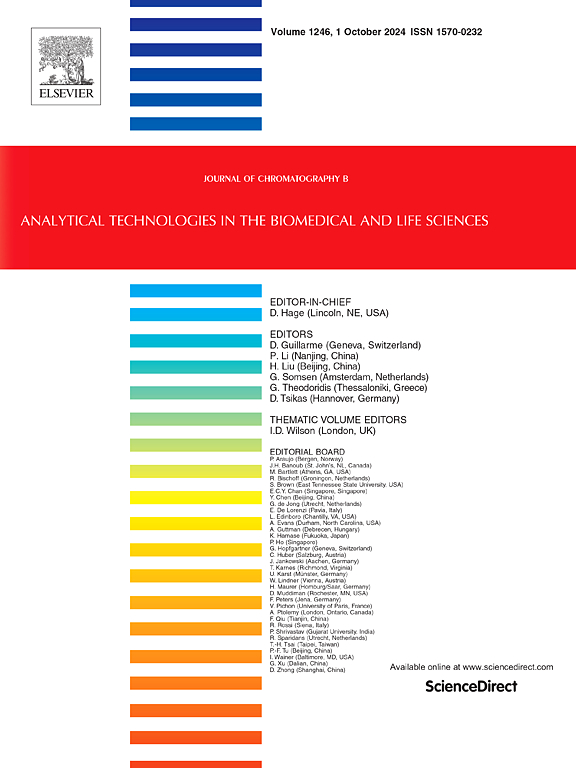QbD and green metric based HPLC method development and validation of bromocriptine mesylate in bulk product and biological samples
IF 2.8
3区 医学
Q2 BIOCHEMICAL RESEARCH METHODS
引用次数: 0
Abstract
Bromocriptine mesylate (BM) is a well-established antiparkinsonian drug, yet its analytical methodologies remain limited in terms of efficiency, cost-effectiveness, and reproducibility from commercial product and biological samples. We aimed at systematic analytical quality by design-assisted method development for routine quantitative assessment. Initially, various plausible variables (peak area, retention time, tailing factor, and plates) were screened using Ishikawa fishbone method. Following risk estimation studies, factor screening exercise was conducted employing a Taguchi design (TgD) for selecting various significant variables. Furthermore, a central composite-design (CCD) was conducted to delineate operable conditions and design space verification using Monte Carlo simulations. In the optimization, flow rate (X1 as A) and the injection volume (X2 as B) were two significant factors against four responses (Y1: peak area, Y2: retention time, Y3: Tailing factor and Y4: Theoretical plate count). The method was validated by estimating validation parameters as per ICH guidelines under environmentally sustainable conditions (using AGREE tools). Finally, optimized mobile phase composition (Acetonitrile (ACN): Trifluoroacetic acid (TFA) 70:30) and the flow rate (0.9 mL.min−1) were set as the optimal chromatographic conditions. The method was found to be highly robust, precise, and sensitive, with a wide linearity range of 0.2–100 μg/mL. Conclusively, AQbD paradigms coupled with simulations enabled in selecting environmentally sustainable and influential method variables, and arriving at the “best possible” chromatographic conditions for effective quantification of BM.

基于QbD和绿色计量的高效液相色谱法在原料药和生物样品中甲磺酸溴隐亭的开发和验证
甲磺酸溴隐亭(BM)是一种成熟的抗帕金森病药物,但其分析方法在效率、成本效益以及商业产品和生物样本的重现性方面仍然受到限制。我们的目标是通过设计辅助方法的开发来系统地提高分析质量,以进行常规定量评估。最初,我们使用石川鱼骨法筛选了各种可能的变量(峰面积、保留时间、尾随因子和平板)。在风险评估研究之后,采用田口设计法(TgD)进行了因子筛选,以选出各种重要变量。此外,还进行了中心复合设计 (CCD),以划定可操作条件,并利用蒙特卡罗模拟验证设计空间。在优化过程中,针对四个响应(Y1:峰面积;Y2:保留时间;Y3:尾随因子;Y4:理论平板数),流速(X1,作为 A)和进样量(X2,作为 B)是两个重要因素。根据 ICH 指南,在环境可持续的条件下(使用 AGREE 工具),通过估算验证参数对该方法进行了验证。最后,优化了流动相组成(乙腈 (ACN):三氟乙酸 (TFA) 70:30)和流速(0.9 mL.min-1)作为最佳色谱条件。该方法稳健、准确、灵敏度高,线性范围为0.2-100 μg/mL。最终,AQbD 范式与模拟相结合,选择了环境可持续的、有影响力的方法变量,并得出了有效定量 BM 的 "最佳 "色谱条件。
本文章由计算机程序翻译,如有差异,请以英文原文为准。
求助全文
约1分钟内获得全文
求助全文
来源期刊

Journal of Chromatography B
医学-分析化学
CiteScore
5.60
自引率
3.30%
发文量
306
审稿时长
44 days
期刊介绍:
The Journal of Chromatography B publishes papers on developments in separation science relevant to biology and biomedical research including both fundamental advances and applications. Analytical techniques which may be considered include the various facets of chromatography, electrophoresis and related methods, affinity and immunoaffinity-based methodologies, hyphenated and other multi-dimensional techniques, and microanalytical approaches. The journal also considers articles reporting developments in sample preparation, detection techniques including mass spectrometry, and data handling and analysis.
Developments related to preparative separations for the isolation and purification of components of biological systems may be published, including chromatographic and electrophoretic methods, affinity separations, field flow fractionation and other preparative approaches.
Applications to the analysis of biological systems and samples will be considered when the analytical science contains a significant element of novelty, e.g. a new approach to the separation of a compound, novel combination of analytical techniques, or significantly improved analytical performance.
 求助内容:
求助内容: 应助结果提醒方式:
应助结果提醒方式:


